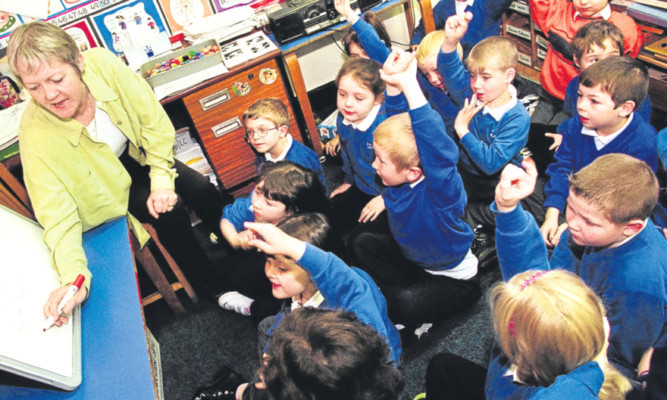
Forget first-class education. Now we have cattle class.
Packed primary schools in Scotland are among the most over-crowded in the Western world.
A damning international report has found Scotland’s primary schools have more pupils per teacher than almost any other developed nation with just Chile and Mexico more stretched.
Worried critics fear the ratio will hamper children’s education at a critical time in their development.
While union leaders claim schools are being forced to swell class sizes due to budget constraints, others argue the number of teachers in a school is not important if the staff are competent and the lessons they deliver are effective.
And the Scottish Government have dismissed the figures from the Organisation for Economic Co-operation and Development as being wide of the mark with their data claiming smaller class sizes.
But Michael Pyke, of the Campaign for State Education, is adamant class size counts when it comes to producing capable future generations.
He said: “If you think the proper way to spend large amounts of taxpayers’ money is, in the most general terms to produce a better society, it is very obvious that if you have a very high ratio of pupils to teachers, it will be very difficult to do that.”
The OECD report revealed in 2012 that primary schools north of the Border had an average of 21.1 pupils per teacher.
That figure represents a 40% leap from 2005 while almost all the other countries recorded a fall.
In Finland, which is considered to have one of the best education systems in the world, there are 13.6 pupils per teacher, Norway has 10.3, Poland 11 and Luxembourg just 9.2.
Experts claim the situation had worsened over decades because establishment politicians send their children to private schools.
Mr Pyke added: “The reason I am not surprised it has got to this very poor level is that the people who predominantly run British society are likely to have their own children privately schooled and thus they do not see the problem.
“In general, British society has always thought the education of the great majority doesn’t really matter.”
The soaring class sizes cover the period since the SNP Government came to power in 2007 and the two years of the previous Labour administration.
The SNP came to power on the back of bold promises they would slash primary classes in the first three years of education.
Their 2007 manifesto vowed to deliver class sizes of just 18 kids but that was scrapped just three years later.
Chris Keates, general secretary of teaching union NASUWT, claimed local authority cuts were at fault for leaving teaching staff over-stretched.
He said: “There is increasing evidence that class sizes are rising in schools. In many cases this is because of reductions in the number of teaching staff.
“Not only is the pupil/teacher ratio at a high level, the pupil/adult ratio is increasing as many vital support staff are being made redundant and schools and local authorities struggle with dwindling budgets.”
Susan Quinn, education convener of Educational Institute of Scotland teachers’ union, said their policy is to campaign for a reduction in class sizes.
She said: “Studies suggest smaller classes allow time for teachers to work with individual pupils in a more efficient manner.”
But Chris McGovern, chairman of the Campaign for Real Education, argued class sizes are less important than the quality of teaching.
He said: “Small class size may be desirable but teaching methodology and teaching quality matters far more.
“In China class sizes average around 50 but many schools operate with much larger numbers. Eighty pupils in a class is not uncommon and in some classes there are 100 pupils. The bottom 10% of Shanghai pupils are ahead of the top 20% of pupils in the UK.”
Scottish Conservative young people spokeswoman Liz Smith said Scotland’s children are being let down by the SNP.
She said: “The SNP has consistently failed to meet the specific class size commitments they promised to the Scottish voters.
“This report just confirms that failure on an international basis.”
The Scottish figures were the same as England with the Scottish Government claiming they were inaccurate.
A Scottish Government spokeswoman said: “We don’t recognise the reported statistics and it appears the figures attributed to Scotland are a lift of the English figures.
“The published Official Statistics show that the average primary class size was maintained between 2008 and 2012 and that the pupil/teacher ratio in our primary schools was 16.3 in 2012.”

Enjoy the convenience of having The Sunday Post delivered as a digital ePaper straight to your smartphone, tablet or computer.
Subscribe for only £5.49 a month and enjoy all the benefits of the printed paper as a digital replica.
Subscribe